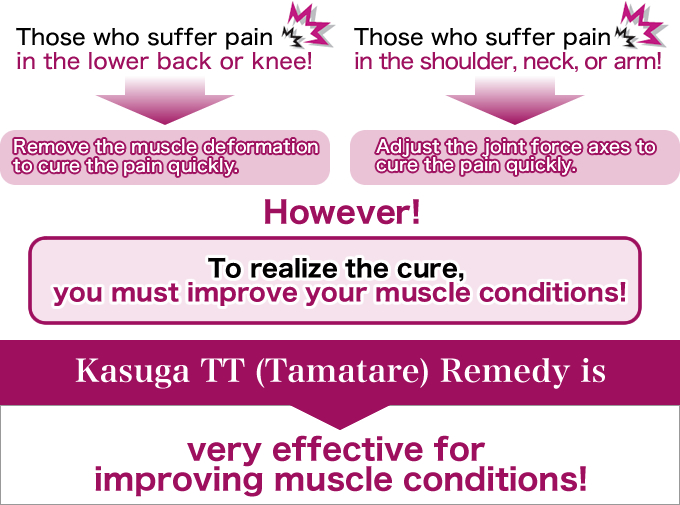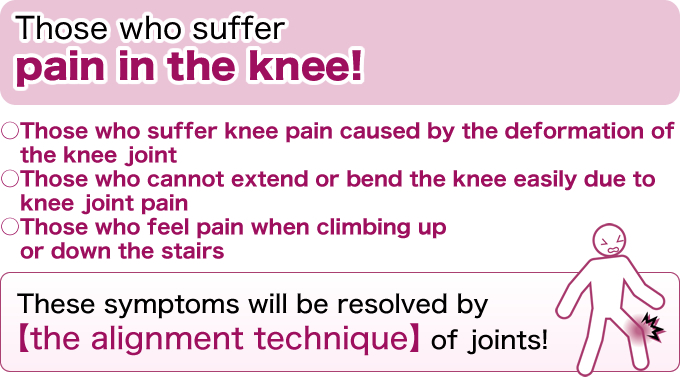- Greeting
- Organization outline
- Tamatare Remedy
- Symptoms and Remedies
- Takanoha Correspondence
- Kasuga Topics
- List of Kasuga Pain Offices across Japan
- Contact



* Kasuga TT (Tamatare) Remedy, which is an improved version of nerve-muscle coordination method, rapidly recovers muscle metabolism, and this in turn dramatically reduces pains and numbness!
* The nerve-muscle coordination method was proven to have a significant effect on muscle metabolism in the Exercise Metabolism session of Japanese Society of Internal Medicine, Kinki Regional Conference, in July 10, 1993. Since then, various remedy methods incorporating its essences have been introduced to the remedy circles, and Hiroshi Kasuga, the head of Tamatare Remedy group, and affiliate clinics nationwide have been relieving many patients from suffering pains and numbness every day.
* One of the features of Kasuga TT (Tamatare) Remedy is that it rapidly improves the muscle-controlling capability of the nerve by stimulating, with hand operation, neuromuscular units, which are the tissue that transmits nerve signals to muscle (muscle spindles distributed at the nerve-muscle contacting points and around the joint). Furthermore, the stretching of muscle fibers that happen during the hand operation removes small spasms (injuries and knots in the muscle, which hamper the blood flow), largely improving the blood flow. Simultaneous realization of these improvements broadens the movable angle of the joint surface, and instantly enables the patient to make improved body movements that were not possible due to pains and numbness.
The human thigh bone bends at the hip joint. The bend is called "neck-shaft angle", and the degree changes with the age. It is about 145 degrees at the age of three, 126 degrees for adults, and 120 degrees for the aged. These shifts are fairly remarkable. As the neck-shaft angle changes, the thighbone's twist angle changes from 4 degrees to 20 degrees. When muscles do not catch up with these changes, they cause pain. If they are muscles around the pelvis or in the back, the lower back becomes prone to ache. If they are anterior or posterior of the thigh, knee pain tends to occur. Removal of muscle twists means adjusting the muscle's movement habits to these bone angles shifts. If you succeed in the adjustment, the pain goes away instantly.

A lower back pain does not tend to stay constantly. In most cases, a sharp pain occurs once in a few months and lasts a few days. In the repetition of this cycle, the symptoms gradually become worse with numbness at the foot, and the time required for recovery becomes longer. If a person feels pain in the lower back, they naturally try to protect it. This rests the muscles of the lower back, temporarily easing the pain. However, when you come to have repeated lower back pain, relying on natural ease of the pain through resting can eventually lead to a serious pain.
At this stage, you need to reduce the load on the lower back by streamlining the force transmission and the coordination of movement between the muscles for moving the pelvis and the muscles for supporting the spine. For example, when you stand upright, the pelvis is positioned askew. When you sit down on a chair, however, the pelvis becomes horizontal. The bending angle of the spine also shifts accordingly. When you stand upright, the spine is bent forward, but when you sit down, it becomes upright. These postures are supported by muscles.
As seen above, the pelvis and the spine are motor bones, and all body movements are made by muscle. A lower back pain that occurs when sitting on a chair and a difficulty in straightening the back when standing up from a chair are some of the examples of muscle coordination problems. These examples are cases of pelvis rotation and spine straightening/bending not being able to catch up with the posture changes, which will develop into lower back pains if some additional factor mingles. There are many cases such as a simple muscle coordination problem as the one described above, and cases of mis-coordination with some other large joints such as the knee joint and the hip joint.
This is why a person with knee pain or hip joint pain tends to have lower back pain as well. For these problems, coordination of muscle and bone forces quickly resolves misalignment of the motor axes causing the lower back pain, and rapidly recovers the range of muscle movement. Our remedy is a set of advanced specialized methods that coordinates muscles and bones effectively, and removes the root causes of sprain pains.
You need to accurately understand the movement of each muscle in order to achieve quick removal of various pains in the neck, shoulder, elbow, and arm. A human stands on two legs now, but in the long course of evolution, there was a length of time in which our ancestors used hands to support the body (for example, by holding on to a tree branch). There is a trace of this human history in the movement of the triangular muscle—a large muscle between the shoulder and arm. The role of this muscle now is just to support the shoulder joint, but it used to directly support the shoulder, the neck, and the portion of the back near the shoulder before humans start to walk upright on two legs. The triangular muscle does not take this role now, but it still has a big influence on the way forces are transmitted between the shoulder and the arm. Especially it plays a significant role as the stress sensor for the shoulder, neck, and arm.

Background of pain development
Haven't you experienced stiff shoulders after a task using fingers or a pain in the neck after overuse of the arm? These symptoms occur because the triangular muscle senses subtle fatigue such as the one at the finger tip and transmits the signal to the shoulder and the neck. The signal becomes stronger when you use your arms excessively. The channel of the signal is of course the nerve. The content of the signal is not only movement orders but also the fatigue of the triangular muscle. (The shoulder joint is supported by the triangular muscle because of its socket-like junction shape without any ligament, unlike other joints such as the knee and ankle. Therefore, when the capability of the triangular muscle lowers, the support of the shoulder weakens endangering even the neck. This is why the fatigue of the triangular muscle is signaled.) Therefore, when the fatigue of the triangular muscle becomes higher than a certain level, the protection mechanism of the neck, shoulder, and the arm instantly takes effect. The protection works by shifting the force axes of the shoulder, elbow, and arm joints to narrow the movement range of the related muscle groups (restriction on usage for safety). The person in question, however, is not conscious of this shift, and tries to move the body in the usual manner. This inevitably sheds a strong load on muscles accumulating the burden while the person is not conscious of making extra physical labor.
Sprain pains of the neck, shoulder, elbow, and arm occur in these backgrounds with some additional causes. The frozen shoulder syndrome due to age shows extreme symptoms. The shoulder joint itself recognizably extends forward, which not only causes very sharp pain, but significantly limits the movement of the shoulder and elbow joints limiting the use of the arm as well as the shoulder. An additional factor in this condition causes even stronger pains.
To remove the pain
Take a natural posture in which you can move with a minimum effort, and put resistance pressure simultaneously on the shoulder, elbow, and wrist to make the misalignment of the joint forces distinct. Then stretch the muscle that causes the misalignment. The joint force axes then align. With aligned axes, the movement range of muscles becomes larger, and accordingly, the movement capacity of the triangular muscle increases. These treatments also remove the burden on other upper limb muscle groups, resolving the sprain pain quickly. The specialized remedy achieving the above is coordination of joint force axes of the shoulder and upper limb.
Start of symptoms
Direct impact should not be placed on any joints including the knee joint. Most of the load on a joint is absorbed by the muscles that move the joint. Therefore, muscles have two roles: exerting force and absorbing loads. The role of absorbing loads protects the joints. Weakened protection of the knee allows the knee joint to be eroded decreasing the amount of cartilage.
Deterioration of symptoms, and extension and bending problems
Of course, the joint will not be eroded without any resistance. It will attempt to protect itself. The measures that it takes are to increase the amount of the bone tissue in the knee joint. This, however, works negatively because the alignment with other joints is lost. As a result, the muscles that should protect the joint become more difficult to fulfill this role, throwing the muscles around the knee joint in an emergency.
Specifically, the tendons on the both ends of the muscle pull the muscle far more strongly than usual. This inhibits the knee from stretching, which is to say the knee makes a dogleg bend. The next thing that happens is misalignment of forces of the knee joint and the joint at the root of the leg, which makes the knee unable to bend further than a certain angle. This happens because the position of the knee joint has shifted.
Forward extension and outer orientation of the knee are examples of knee joint shifts. These shifts contribute to further development of knee joint deformation. The force exertion role of the muscle has deteriorated considerably at this stage. These conditions of knee joints, and muscles and tendons that move the knee joints, are found in those who have problems and pains in everyday movement. So how do we resolve sprain pains, which occur with an additional factor in the above conditions, as well as accompanying disability of movement, so that you do not feel pains in everyday life? We need to resolve the problems you have experienced in the past starting from the present symptom step-by-step in the backward direction as if we are turn the clock backward from today to the day of the first symptom. In doing so, the most important thing is to recover the muscle capability. The pain that occur with a movement, or by the manner of the movement, originates from the muscle—the instrument for the movement—and the nerve that moves the muscle. The nerve that moves the knee runs densely like blood vessels from the root of the leg through the anterior and posterior of the thigh and around the joint. The intensity and nature of the pain are determined by the capability level of the muscle.
The alignment technique of joints resolves the knee pain quickly
A sprain pain of the knee joint caused through the background explained above is accompanied by a deformation of the knee joint that progresses during the developing stage of the problem as well as the stage where the problem has developed and become constant. To explain the manner of deformation, let's look at the age-related knee pain, in which characteristic bone orientation and alignment are observed.
As we have explained above, the human thigh bone bends at the hip joint. The bend is called "neck-shaft angle", and it changes with the age. The average angle of this bend at the age of three is 145 degrees, while that of adults is about 126 degrees. The average angle of the aged is about 120 degrees. This change of angle greatly affects the movement of the hip joint accordingly, but since this change of angle usually develops slowly in a long period of time, the muscles that move the hip joints ordinarily catch up with the change. However this adjustment of muscle occurs under one condition: the angle of the pelvis changes accordingly. This change automatically leads to another change, which is a change in the twist angle of the thighbone. The range of the twist angle is between 4 and 20 degrees, which is fairly large. Most of the muscles can adjust themselves to the changes of the neck-shaft angle and the pelvis orientation. However, there is one muscle that does not adjust itself easily. It is a thigh muscle called quadriceps muscle, which is responsible for 70% of the task of protecting the thigh bone, and bending and extending the knee. This muscle has a significant bearing on the change of the twist angle of the thigh bone. In normal cases, the twist angle of the thigh bone is naturally adjusted to the pelvis orientation. However, deformation of the knee joint prevents this natural adjustment of the twist angle, which then induces a twist of the shinbone. This is why a person with knee joint deformation is often bow-legged, and their soles are often bent inside. The three joints (the knee joint, the hip joint, and the foot joint) become misaligned through the above-described process.
A sprain pain occurs when another factor is added to this misalignment. The pain deteriorates the symptom further and forms so called vicious cycle of pain. Therefore you have to start with breaking this vicious cycle in order to resolve the knee pain. For this problem, the alignment technique of the knee joint is very effective. The alignment technique of joints uses muscles. The most dominant instruments for moving joints including the knee joint are muscles. Therefore, the alignment of joints is achieved by changing the habit of muscle movement so as to have muscles support joint positions from the right angle, and most pains will disappear quickly.
Road to permanent resolution of the knee pain
The alignment of the three joints tentatively removes the pain quickly, but a permanent resolution requires two more elements. One is removing excessive tension of the tendon, and the other is vitalizing the muscle. The tendon and the muscle are different tissues, but they work together. The muscle exerts or loosens force through the tendon. This relationship is often compared to the relationship between the accelerator and the brake of a vehicle. The muscle is the accelerator and the tendon is the brake. A knee joint deformation degrades the tendon functionality. In other words, the brake function degrades. If you a driver of a car with its brake degraded, you probably cannot step on the accelerator. In the case of a bicycle, you cannot push the pedal hard. A person with a knee pain has this phenomenon in the muscles and tendons that move the knee joint. A person who feels pain when climbing down the stairs, for example, cannot have the muscle exert the necessary force (nerve-muscle communication failure). This happens against the person's will. Therefore, for a permanent resolution of the knee pain, you have to restore the control function of the tendon and the muscle.
Remedy specialized "Takanoha Correspondence"
Issued by Hiroshi Kasuga, Kasuga Sports Medicine Research Center






